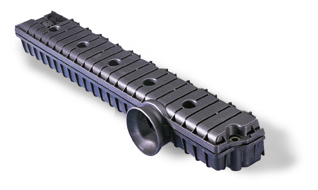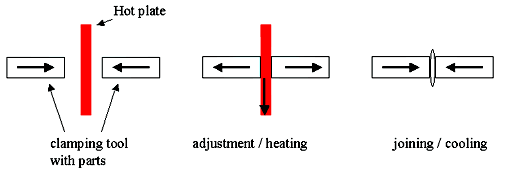|
|
Hot Plate Welding | When thermoplastic parts are being welded with a hot plate, the join partners are plasticized by means of a heat element and then joined together under pressure. The parts can be plasticized either through contact with the heat element or by heat radiation, without contact.

 | | Intercooler manifold, Mercedes BR900 6-cylinder engine |

- Cost-effective process
- Large batch sizes possible
- Weld line can take heavy mechanical load
- Same strength as basic material can be attained

 | | Basic principle of hot-plate welding process | When parts are being welded together by a hot plate, the join partners are clamped in place on the moving slides of the machine and run up against the hot plate. The contact process is started under the warming-up pressure; the purpose of this is to overcome the tolerance and attain a uniform contact surface at the hot plate. Once the preset travel distance has been reached, the heating phase starts in which a melt cushion is created under virtually no pressure at all. Then the slides are run back until the hot plate can be with-drawn completely freely, and then the welding process as such starts in which the melted join partners are pressed together to form the join.

 | | Diagram showing the sequence of hot plate welding | All Lanxess thermoplastic materials can be hot-plate-welded, but Durethan® KU2-2140/30 was developed specifically for this process. Its distinguishing features are a lower level of melting adhesion and a bigger welding-process window. This has been achieved by increasing the melt viscosity.


- 3-dimensional contours are easy to achieve with contour heating elements.
- Tight weld lines are easy to achieve, due to the high melt-layer density and consequent big welding displacement.
- Hard-soft combinations are basically possible as well, but a certain minimum dimensional stability must be ensured.
- The cycle time is very high, at least 40 seconds, or 10 to 15 seconds less in the case of high-temperature welding (over 400 °C).
- The resultant melt flash can be covered with a flash trap.
- Due to the low welding force of small join areas, these can only be welded with special equipment.
- With certain materials, the melt adhesion at the heating element can result in stringing or even in a partial shearing-off of the melt. It is possible to work with a Teflon non-stick coating at heating-element temperatures up to about 260 °C.


Recommended setting parameters:

| Resin | Hot Plate Temperatures | Joining Pressure | | Centrex® ASA | 230 - 410 °C | 0,4 - 0,8 N/mm2 | | Durethan® PA 6 and 66 | 280 - 450 °C | 0,1 - 1,0 N/mm2 | | Lustran® ABS / Novodur | 230 - 410 °C | 0,4 - 0,8 N/mm2 | | Pocan® PBT | 280 - 350 °C | 0,1 - 1,0 N/mm2 | | Triax® PA+ABS | 250 - 410 °C | 0,2 - 0,9 N/mm2 | Various different types of drive technology are in use in hot plate welding machines:

- Electric motors (greatest accuracy, highest process speeds)
- Pneumatic (lowest-cost process variant)
- Hydraulic (greatest force and adequate accuracy)

The materials used for the heating element are aluminum-bronze alloys, or high-strength aluminum alloys for the lower temperatures and steel for high-temperature welding.

| | |
 |
|
|
|
|